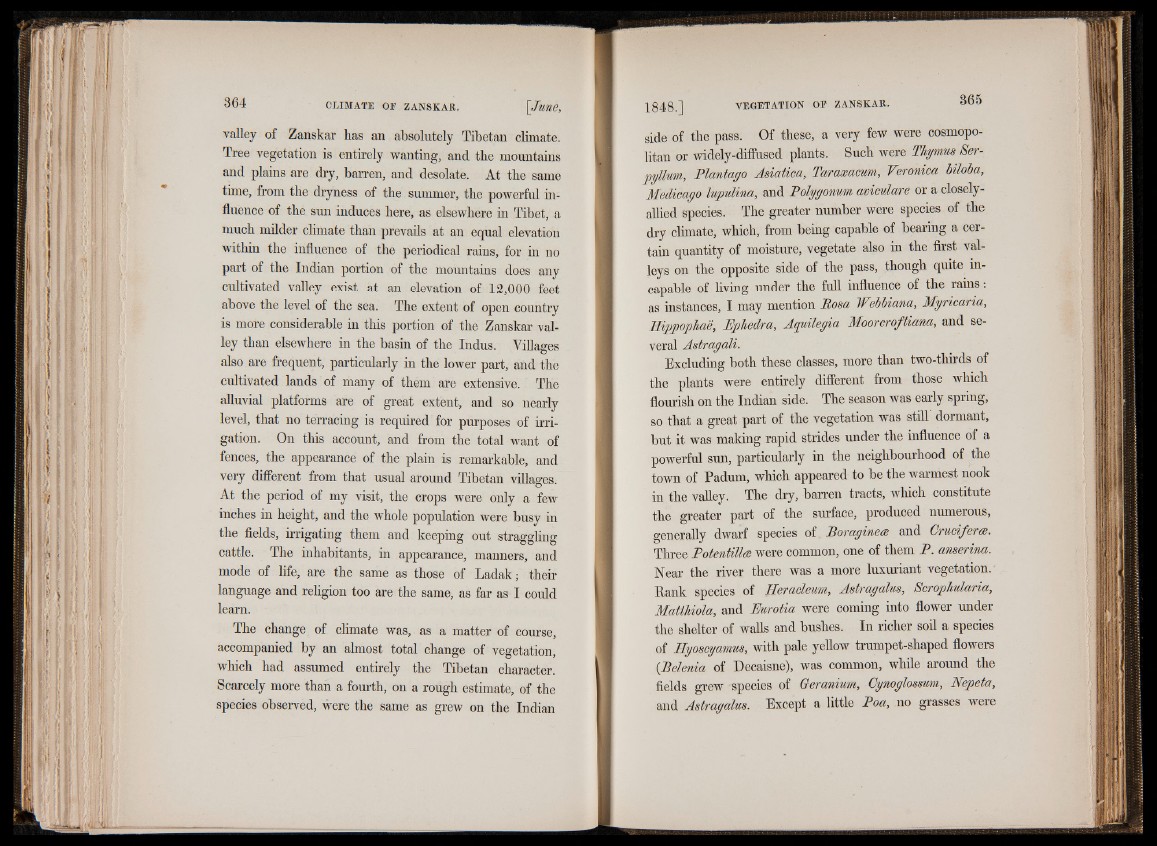
valley of Zanskar has an absolutely Tibetan climate.
Tree vegetation is entirely wanting, and the mountains
and plains are dry, barren, and desolate. At the same
time, from the dryness of the summer, the powerful influence
of the sun induces here, as elsewhere in Tibet, a
much milder climate than prevails at an equal elevation
within the influence of the periodical rains, for in no
part of the Indian portion of the mountains does any
cultivated valley exist at an elevation of 12,000 feet
above the level of the sea. The extent of open country
is more considerable in this portion of the Zanskar valley
than elsewhere in the basin of the Indus. Villages
also are frequent, particularly in the lower part, and the
cultivated lands of many of them are extensive. The
alluvial platforms are of great extent, and so nearly
level, that no terracing is required for purposes of irrigation.
On this account, and from the total want of
fences, the appearance of the plain is remarkable, and
very different from that usual around Tibetan villages.
At the period of my visit, the crops were only a few
inches in height, and the whole population were busy in
the fields, irrigating them and keeping out straggling
cattle. The inhabitants, in appearance, manners, and
mode of life, are the same as those of Ladak; their
language and religion too are the same, as far as I could
learn.
The change of climate was, as a matter of course,
accompanied by an almost total change of vegetation,
which had assumed entirely the Tibetan character.
Scarcely more than a fourth, on a rough estimate, of the
species observed, were the same as grew on the Indian
side of the pass. Of these, a very few were cosmopolitan
or widely-diffused plants. Such were Thymus Ser-
pyllum, Plantago Asiatica, Taraxacum, Veronica biloba,
Medicago lupulina, and Polygonum aviculare or a closely-
allied species. The greater number were species of the
dry climate, which, from being capable of bearing a certain
quantity of moisture, vegetate also in the first valleys
on the opposite side of the pass, though quite incapable
of living under the full influence of the rains:
as instances, I may mention Rosa Webbiana, Myricaria,
Hippophae, Ephedra, Aquilegia Moorcroftiana, and several
Astragali.
Excluding both these classes, more than two-thirds of
the plants were entirely different from those which
flourish on the Indian side. The season was early spring,
so that a great part of the vegetation was still' dormant,
but it was making rapid strides under the influence of a
powerful sun, particularly in the neighbourhood of the
town of Padum, which appeared to be the warmest nook
in the valley. The dry, barren tracts, which constitute
the greater part of the surface, produced numerous,
generally dwarf species of Poraginets and Crucifer at.
Three Potentillce were common, one of them P. anserina.
Near the river there was a more luxuriant vegetation.
Rank species of Heracleum, Astragalus, Scrophularia,
Matihiola, and Eurotia were coming into flower under
the shelter of walls and bushes. In richer soil a species
of Hyoscyamus, with pale yellow trumpet-shaped flowers
{Pelenia of Decaisne), was common, while around the
fields grew species of Geranium, Cynoglossum, Nepeta,
and Astragalus. Except a little Poa, no grasses were